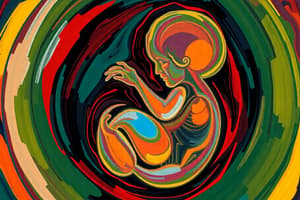Podcast
Questions and Answers
What is the most common condition requiring medical attention in newborn infants?
What is the most common condition requiring medical attention in newborn infants?
- Low oxygen during delivery
- Neonatal Jaundice (correct)
- Birth defects
- Birth trauma
Under which circumstance is the risk of brain injury from low oxygen during birth notably elevated?
Under which circumstance is the risk of brain injury from low oxygen during birth notably elevated?
- In breech births (correct)
- If the delivery is quick
- When the mother is Rh negative
- When the baby is smaller than average
What causes neonatal jaundice in infants?
What causes neonatal jaundice in infants?
- High levels of bilirubin in the blood (correct)
- Maternal smoking
- Infection during birth
- Excess intake of calcium
Which maternal blood type has a risk of producing antibodies that may harm the fetus?
Which maternal blood type has a risk of producing antibodies that may harm the fetus?
How can untreated neonatal jaundice potentially harm an infant?
How can untreated neonatal jaundice potentially harm an infant?
What percentage of stillbirths occur in babies born before 28 weeks gestation in the US?
What percentage of stillbirths occur in babies born before 28 weeks gestation in the US?
What is one of the main causes of re-hospitalization among infants after birth?
What is one of the main causes of re-hospitalization among infants after birth?
Which of the following risk factors is NOT associated with stillbirth?
Which of the following risk factors is NOT associated with stillbirth?
What percentage of stillbirths occur after 28 weeks gestation in the US?
What percentage of stillbirths occur after 28 weeks gestation in the US?
What practice is done within 48 hours of a newborn's birth?
What practice is done within 48 hours of a newborn's birth?
Which demographic shows a doubled stillbirth rate due to social factors and healthcare disparities?
Which demographic shows a doubled stillbirth rate due to social factors and healthcare disparities?
Which disease is screened for in newborn screening programs?
Which disease is screened for in newborn screening programs?
What is the average length of hospital stay for mothers and infants after birth?
What is the average length of hospital stay for mothers and infants after birth?
Flashcards
Neonatal Jaundice
Neonatal Jaundice
A condition seen in newborns with a yellowish appearance of the skin and eyes due to excess bilirubin in the blood.
RhoGAM
RhoGAM
A medication given to Rh-negative mothers to prevent the production of antibodies that could attack the fetus's red blood cells during future pregnancies.
Blood Type Incompatibility
Blood Type Incompatibility
A medical condition that occurs when a baby's blood type is incompatible with the mother's blood type, often leading to jaundice.
Birth Asphyxia
Birth Asphyxia
Signup and view all the flashcards
Bili Lights
Bili Lights
Signup and view all the flashcards
What is stillbirth?
What is stillbirth?
Signup and view all the flashcards
Why are babies born before 28 weeks at high risk?
Why are babies born before 28 weeks at high risk?
Signup and view all the flashcards
What is a heel stick?
What is a heel stick?
Signup and view all the flashcards
What is asphyxia?
What is asphyxia?
Signup and view all the flashcards
What is birth trauma?
What is birth trauma?
Signup and view all the flashcards
What are the most common reasons for newborns to be re-hospitalized?
What are the most common reasons for newborns to be re-hospitalized?
Signup and view all the flashcards
What is the stillbirth rate in the US?
What is the stillbirth rate in the US?
Signup and view all the flashcards
Why is the stillbirth rate higher in American non-Hispanic Black families?
Why is the stillbirth rate higher in American non-Hispanic Black families?
Signup and view all the flashcards
Study Notes
Stillbirth
- Stillbirth is death just before or during delivery after 20 weeks of pregnancy
- US stillbirth rate is 6 per 1,000 live births, half related to prematurity (before 28 weeks)
- Stillbirth rates: Post-28 weeks gestation in the US is 3 per 1,000 live births
- Worldwide, rate is 14 per 1,000 live births
- Social factors and healthcare disparities double stillbirth rate for American non-Hispanic Black families, mainly due to prematurity
- Risk factors for stillbirth include first birth, maternal age, maternal medical problems, and prior stillbirth
- Birth defects are a cause of 20% of stillbirths and early neonatal deaths
Newborn Screening
- Most states mandate newborn screening: hearing test, heel stick (blood test), and blood oxygen check
- Heel stick within 48 hours for genetic disorder testing
- Newborn screening may test for up to 50 diseases (PKU, sickle cell, hypothyroidism)
- Approximately 3,000 newborns annually test positive for a screened disorder
Postnatal Care and Rehospitalization
- Average mother-infant hospital stay is 39 hours
- This short stay may not allow time to detect serious conditions
- 7.9% of infants are rehospitalized after birth
- Common rehospitalization causes: jaundice (84%), blood infection (sepsis) (11%), and respiratory infection (5%)
Birth Trauma and Asphyxia
- Birth trauma (head, neck, or shoulder injury) affects 0.2% of live births
- Asphyxia (lack of oxygen) during birth
- 80% of births have low oxygen during delivery, which may reduce APGAR score and potentially cause brain injury (0.2% instances)
- Birth trauma and asphyxia more common in babies >8 lbs 13 oz, with large heads, birth defects, or breech births
- Small and premature babies more vulnerable to low oxygen injury
Neonatal Jaundice
- Jaundice is the most frequent condition needing treatment in newborns
- Affects ~50% of full-term and ~80% of preterm babies within the first week
- Caused by excess bilirubin
- Visible symptoms include yellowing skin and eyes, brown urine
- Potential causes: breast milk, blood type incompatibility (mother-baby)
- Rh-negative mothers should receive RhoGAM to prevent future pregnancy complications
Studying That Suits You
Use AI to generate personalized quizzes and flashcards to suit your learning preferences.




